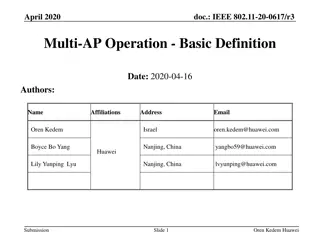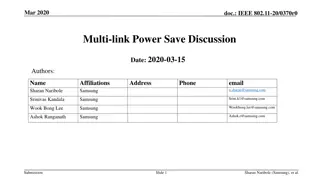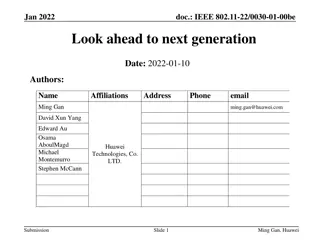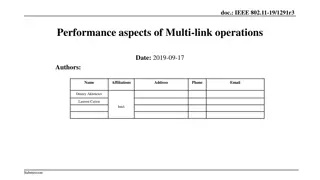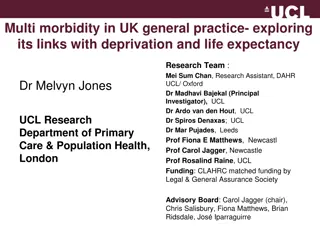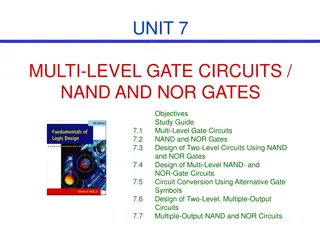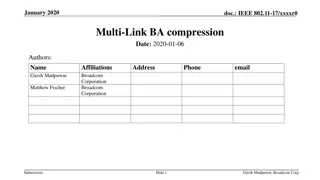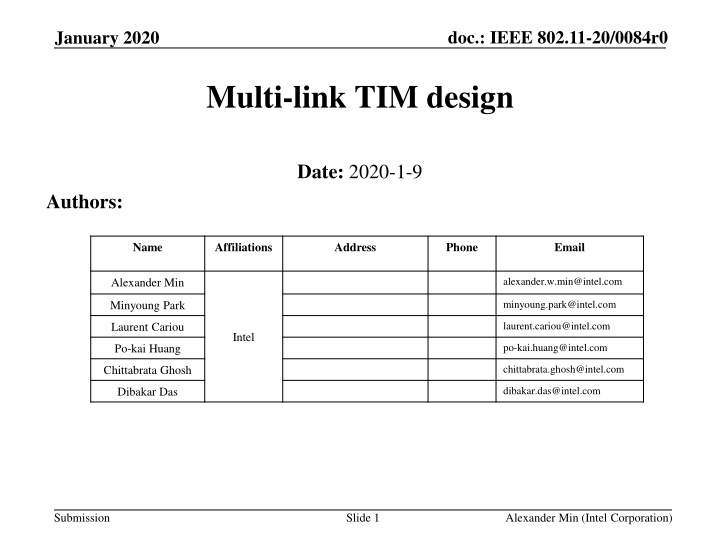
IEEE 802.11-20/0084r0 Multi-link Traffic Indication Map Design
Dive into the design options for Traffic Indication Map (TIM) in 802.11be multi-link Power Save Mode (PSM) operations. Explore the concepts of Multi-link TIM (ML-TIM) and compare legacy TIM element reuse with a separate ML-TIM element approach. Understand the benefits and considerations of each design option and get insights into a proposed ML-TIM element with an example frame format.
Download Presentation

Please find below an Image/Link to download the presentation.
The content on the website is provided AS IS for your information and personal use only. It may not be sold, licensed, or shared on other websites without obtaining consent from the author. If you encounter any issues during the download, it is possible that the publisher has removed the file from their server.
You are allowed to download the files provided on this website for personal or commercial use, subject to the condition that they are used lawfully. All files are the property of their respective owners.
The content on the website is provided AS IS for your information and personal use only. It may not be sold, licensed, or shared on other websites without obtaining consent from the author.
E N D
Presentation Transcript
doc.: IEEE 802.11-20/0084r0 January 2020 Multi-link TIM design Date: 2020-1-9 Authors: Name Affiliations Address Phone Email alexander.w.min@intel.com Alexander Min minyoung.park@intel.com Minyoung Park laurent.cariou@intel.com Laurent Cariou Intel po-kai.huang@intel.com Po-kai Huang chittabrata.ghosh@intel.com Chittabrata Ghosh dibakar.das@intel.com Dibakar Das Submission Slide 1 Alexander Min (Intel Corporation)
doc.: IEEE 802.11-20/0084r0 January 2020 Abstract This presentation discusses two options for TIM (Traffic Indication Map) design for 802.11be multi-link PSM operations Multi-link TIM (ML-TIM) concept was proposed in [11-19/1544r0] We discuss two approaches for multi-link PSM operation Reuse legacy TIM element to convey TIM information for all the links Use a separate ML-TIM element to convey TIM information for other links We compare pros and cons of two design options We propose ML-TIM element with an example frame format Detailed frame format design is TBD Submission Slide 2 Alexander Min (Intel Corporation)
doc.: IEEE 802.11-20/0084r0 January 2020 Background Multi-link TIM Multi-link TIM (ML-TIM) indicates buffered data for other links Each AP in AP MLD (multi-link device) conveys a separate ML-TIM element for buffered data information for other links Each STA in non-AP MLD can receive Beacons in any link and uses an ML-TIM element to obtain per-link traffic information without needing to receive Beacons in all the links better power save Submission Slide 3 Alexander Min (Intel Corporation)
doc.: IEEE 802.11-20/0084r0 January 2020 Option 1 : Legacy TIM approach Reuse legacy TIM to convey TIM information all the links Goal is to reuse legacy TIM element in Beacon and include TIM information for other links Use different/non-overlapping range of AIDs per link per AP STAs in a non-AP MLD gets an AID per link chosen from different range of AIDs E.g., AID 5 for STA 1 from AID range [1-600], and AID 610 for STA 2 from AID range [601-1200] Bit locations corresponding to AIDs 5 & 610 Bit locations corresponding to AIDs 5 & 610 010 001 001 010. TIM bitmap TIM bitmap Non-AP MLD AP MLD TIM TIM Beacon Beacon AID range : [1-600] AP 1 STA 1 Link 1 (AID: 5) Tx/Rx activities AID range : [600-1200] AP 2 STA 2 Link 2 (AID: 610) time : Awake : Doze : Beacons : Data frames Submission Slide 4 Alexander Min (Intel Corporation)
doc.: IEEE 802.11-20/0084r0 January 2020 Option 2 : ML-TIM approach Use ML-TIM to convey TIM information per link Goal is to avoid the constraints of different non-overlapping range of AIDs Include partial virtual bitmaps for other links in a different element with Link ID This allows two options for AID allocation 2-a) Have the same AID for all the STAs in a non-AP MLD 2-b) Have different AIDs per STA, but with the ability to reuse the range of AIDs used in other links Bit location corresponding to AID 5 Bit location corresponding to AID 5 ML-TIM indicates data buffered for AID 5 at AP MLD in Link 2 TIM indicates data buffered for AID 5 at AP MLD in Link 1 2 00101 TIM bitmap 00001 TIM bitmap 2 00001 TIM bitmap 00101 TIM bitmap Link ID Link ID Non-AP MLD AP MLD TIM ML-TIM TIM ML-TIM Beacon Beacon AP 1 STA 1 Link 1 (ID: 1) (AID: 5) Tx/Rx activities AP 2 STA 2 Link 2 (ID: 2) (AID: 5) time : Awake : Doze : Beacons : Data frames Submission Slide 5 Alexander Min (Intel Corporation)
doc.: IEEE 802.11-20/0084r0 January 2020 Comparison of two options Comparison of legacy TIM vs. ML-TIM for multi-link PSM Option 1 (Legacy TIM) Option 2 (ML-TIM) Per-link AID allocation Required Not required Link ID Not required Required TID-link mapping Supported (via AID) Supported (vid Link ID) AID allocation coordination (example in slide 7) Require minimal (or no) coordination among APs for AID allocation May require coordination among APs for AID allocation Required # of AID values may increase by # of links Required # of AID values remains the same as single link AID space Require a single legacy TIM element but with an extended partial virtual bitmap size MAC overhead (example in slide 8) Require multiple partial virtual bitmaps per link Submission Slide 6 Alexander Min (Intel Corporation)
doc.: IEEE 802.11-20/0084r0 January 2020 Example scenario 1 Legacy TIM approach may require coordination among APs to maintain efficiency in TIM bitmap construction Consider a scenario where AP 1 and AP 2 in AP MLD shares the entire AID range and allocate consecutive AID values for multiple link AIDs 1-2 for links 1 and 2 for STA 1, AIDs 3-4 for links 1 and 2 for STA 2, etc. In this case, the total size of partial virtual bitmap field(s) can be the same (i.e., 40 bits) for both legacy TIM and ML-TIM approaches However, such operation requires a tight coordination among APs for AID allocation Non-AP MLLEs AP MLD STA STA STAs AID range : [odd #s] AID allocation 1, 3, , 39 AP 1 Link 1 STA STA STAs AID range : [even #s] AID allocation 2, 4, , 40 AP 2 Link 2 20 STAs Submission Slide 7 Alexander Min (Intel Corporation)
doc.: IEEE 802.11-20/0084r0 January 2020 Example scenario 2 ML-TIM can be more efficient in terms of TIM bitmap construction Consider a scenario where AP 1 and AP 2 in AP MLD have separate AID range 1-600 for AP 1 in link 1 and 601-1200 for AP 2 in link 2 Legacy TIM: Size of the partial virtual bitmap (PVB) can be 620 bits (1-620) ML-TIM: Total size of PVB fields can be 2x20 = 40 bits (1-20 and 601-620) To avoid such inefficiency in TIM construction, legacy TIM approach requires more careful coordination among APs regrading AID allocation, adding more complexity Non-AP MLLEs AP MLD STA STA STAs AID range : [1-600] AID allocation 1, 2, , 20 AP 1 Link 1 STA STA STAs AID range : [601-1200] AID allocation 601, 602, , 620 AP 2 Link 2 20 STAs Submission Slide 8 Alexander Min (Intel Corporation)
doc.: IEEE 802.11-20/0084r0 January 2020 Example ML-TIM element format ML-TIM element format includes Link ID: indicates target link Per-link TIM information: indicates link-specific TIM bitmap information ML-TIM can convey TIM information for multiple links Per-link TIM information subfields can be concatenated (as shown in figure below) Example ML-TIM frame format (detailed design is TBD) TBD TBD TBD TBD 0 or 1 Octets: 1 1 Element ID Extension Per-link TIM Information Per-link TIM Information Element ID Length Link ID Link ID For link x For link y Submission Slide 9 Alexander Min (Intel Corporation)
doc.: IEEE 802.11-20/0084r0 January 2020 Conclusion We compare two design options for multi-link PSM Option 1 : Reuse legacy TIM element to convey TIM information for all the links Option 2 : Use a separate ML-TIM element to convey TIM information for other links We prefer ML-TIM element approach (Option 2 as shown in Slide 5) No need to allocate AID per STA in non-AP MLD Reuse the concept of Link ID and avoid redundancy with AID Achieve high MAC efficiency by minimizing TIM bitmap size In addition, a single ML-TIM element can concatenate multiple per-link TIM bitmaps Allow more modular design w/ higher efficiency and scalability going forward Submission Slide 10 Alexander Min (Intel Corporation)
doc.: IEEE 802.11-20/0084r0 January 2020 References [1] 11-19/1544r0, Multi-link Power Save Operation Submission Slide 11 Alexander Min (Intel Corporation)
doc.: IEEE 802.11-20/0084r0 January 2020 Straw poll Which option do you support? Option 1: Single TIM (legacy TIM with multiple AIDs assigned to a single non-AP MLD) Option 2: Multiple TIM (separate TIM information per link) Submission Slide 12 Alexander Min (Intel Corporation)


